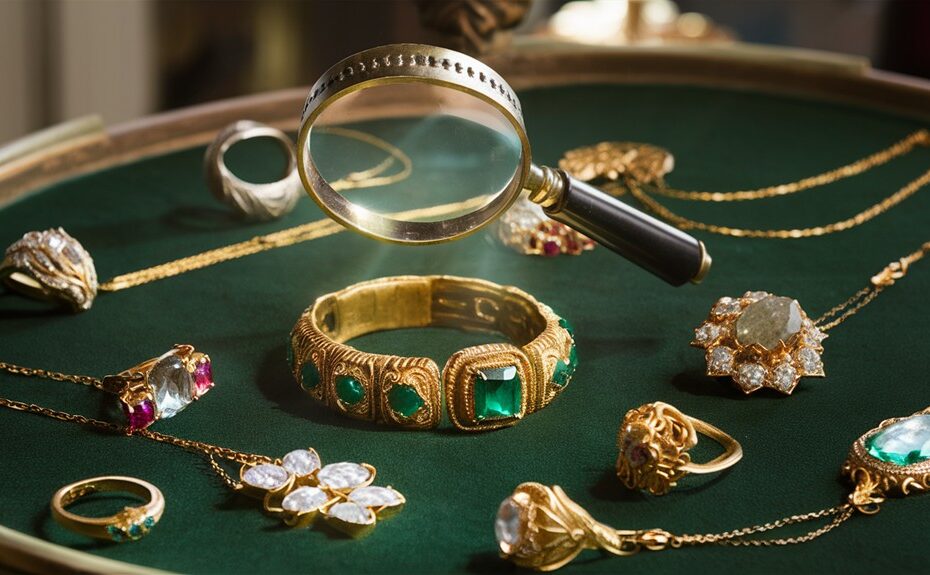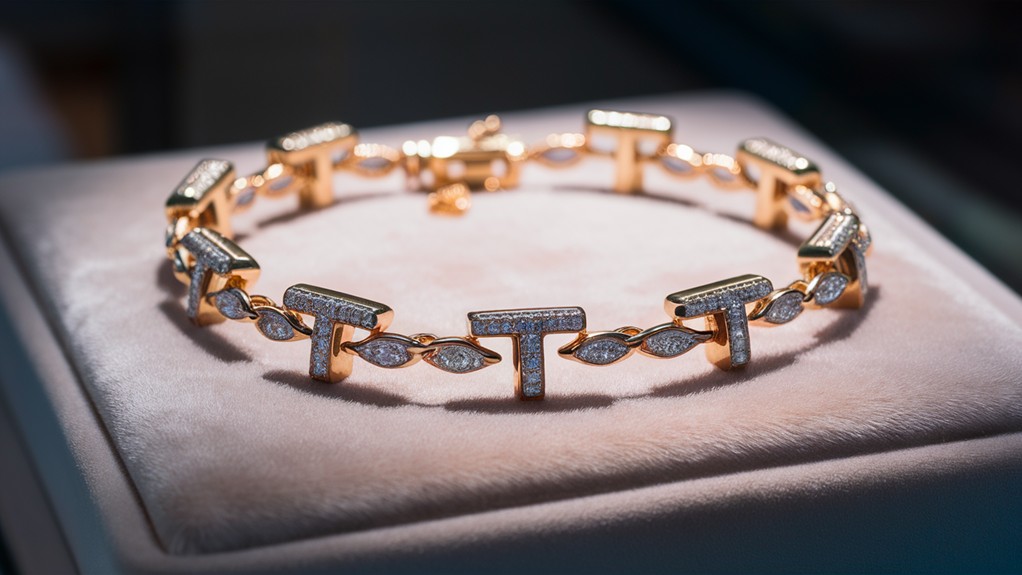When you're faced with a piece of estate jewelry, you're holding more than just precious metals and gemstones—you're cradling a fragment of history. Determining its true value requires a keen eye and expert knowledge. From the intricacies of craftsmanship to the significance of hallmarks, each element plays a vital role in assessing worth. But don't be fooled; market trends can dramatically shift a piece's value overnight. Whether you're inheriting, selling, or simply curious, understanding the complexities of estate jewelry valuation is fundamental. So, what hidden stories and value might your vintage treasures hold?
Our Highlighted Points
- Vintage (20-99 years old) and antique (100+ years old) jewelry values are influenced by materials, condition, provenance, and historical significance.
- Hallmarks and maker's marks help determine age, authenticity, and resale potential, significantly impacting the piece's value.
- Professional appraisals provide accurate evaluations based on market trends and are crucial for insurance, selling, and informed decision-making.
- The value of estate jewelry is assessed through retail, liquid, and fundamental values, considering market conditions and intrinsic worth.
- Rarity, unique designs, and renowned designers increase market value, with current trends favoring Art Deco and Victorian-era pieces.
Understanding Estate Jewelry Classification
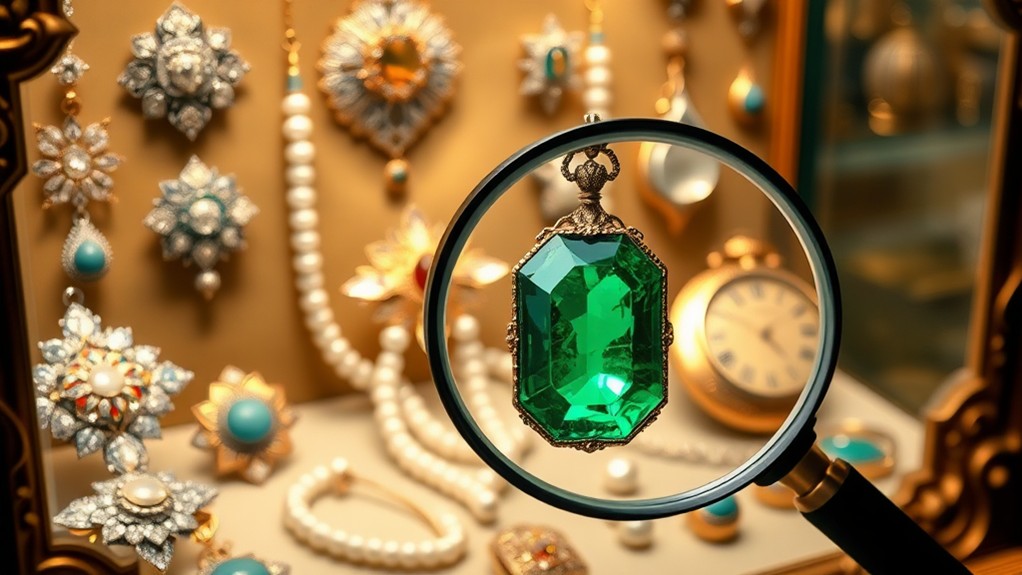
In the world of estate jewelry, classification is key to understanding a piece's true value. When assessing estate jewelry, you'll encounter two primary categories: vintage and antique. Vintage pieces are 20-99 years old, while antique items are over a century old. This distinction is critical for determining market value and historical significance.
To accurately classify estate jewelry:
- Examine design trends:
- Vintage pieces often reflect specific periods (e.g., Art Deco, Retro)
- Antique jewelry showcases earlier craftsmanship styles
- Assess rarity:
- Unique designs or pieces by renowned designers impact classification
- Rarity considerably influences market value
- Identify hallmarks and maker's marks:
- These important identifiers help determine age and authenticity
- They play a significant role in classification and potential resale value
Understanding these factors is fundamental for accurate valuation. Each category appeals to different buyer demographics and market trends, affecting the piece's worth.
Key Factors Influencing Value
When assessing estate jewelry value, several key factors come into play. To determine its general worth, you'll need to take into account the materials used, historical significance, and rarity of the piece. Vintage and antique jewelry often commands higher prices because of its unique designs and cultural relevance. Additionally, the craftsmanship and intricacy of the piece can greatly impact its value. Detailed jewelry appraisal methods, such as evaluating the cut, clarity, and carat of any gemstones, can also influence the overall assessment of the jewelry’s worth. It’s important to seek the expertise of a professional appraiser to get an accurate valuation of estate jewelry before buying or selling.
The condition of the item is essential; well-maintained pieces fetch better prices than those showing signs of wear. Moreover, the maker's mark can greatly improve collectability, especially for renowned designers like Tiffany & Co. or Cartier.
Market trends play an important role in estate jewelry valuation. Demand for specific styles or periods, such as Art Deco or Victorian, can greatly impact an item's desirability and overall value.
| Factor | Impact on Value |
|---|---|
| Rarity | High |
| Materials | Significant |
| Condition | Essential |
To accurately assess estate jewelry, take into account these elements:
- Precious metals used (gold, silver, platinum)
- Quality and type of gemstones
- Historical significance or provenance
- Maker's mark and designer reputation
- Current market demand for the style or period
Materials and Craftsmanship Evaluation
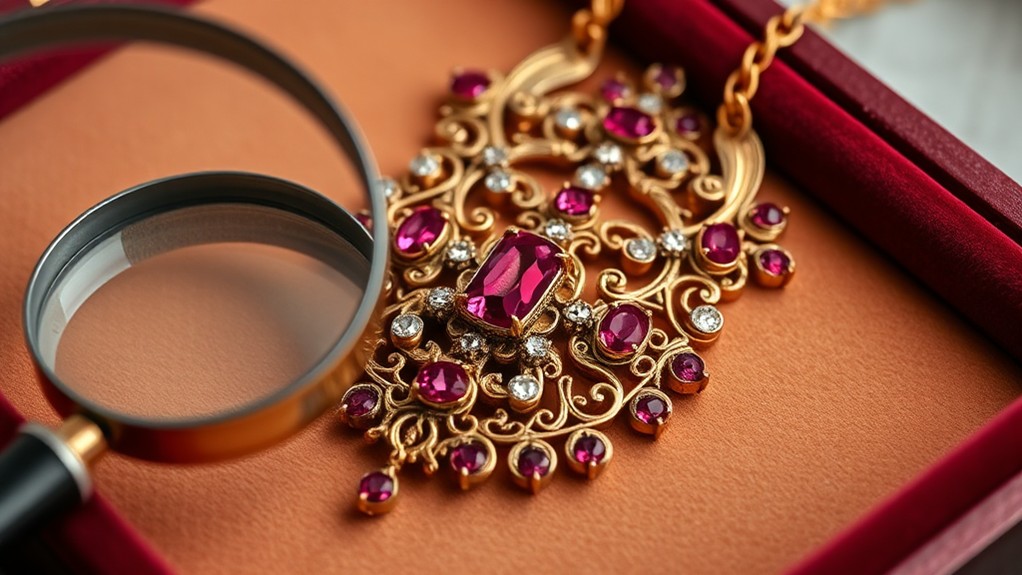
Evaluating the materials and craftsmanship of estate jewelry is fundamental for determining its true worth. When assessing vintage pieces, you'll need to carefully examine the materials used, as they markedly impact the item's inherent worth. Precious metals like gold, silver, and platinum offer higher value owing to their durability and market demand.
Moreover, high-quality gemstones can dramatically increase a piece's value, with factors such as cut, clarity, color, and carat weight playing pivotal roles.
Craftsmanship is similarly significant in valuation. Handmade pieces and those featuring intricate designs or unique settings generally command higher prices than mass-produced items. Look for jewelry hallmarks and maker's marks, as they provide critical information about authenticity and craftsmanship, often enhancing collectability and market value.
The condition of both materials and craftsmanship directly affects an item's worth. Well-maintained pieces with minimal signs of wear are typically more desirable and valuable.
When evaluating estate jewelry, consider:
- Metal purity and quality
- Gemstone characteristics and rarity
- Design intricacy and originality
- Presence of hallmarks or signatures
- Comprehensive condition and signs of wear
Hallmarks and Maker's Marks
Nearly every piece of estate jewelry bears hallmarks or maker's marks, which serve as vital identifiers for authentication and valuation. When assessing vintage jewelry or antique items, these marks provide important information about the piece's origin, quality, and historical significance.
Hallmarks indicate the metal's purity, with common gold purity stamps like 18K (75% pure) and 14K (58.3% pure) adhering to the Gold and Silver Stamping Act in the United States. Maker's marks, conversely, reveal the manufacturer or designer, offering insights into the piece's provenance and potential value.
To effectively use hallmarks and maker's marks in your jewelry appraisal process:
- Familiarize yourself with common hallmarks and their meanings
- Research maker's marks to identify specific designers or periods
- Document all marks found on the piece for future reference
Understanding these marks is vital for establishing a piece's collectability and market value. Well-documented provenance, including hallmarks and maker's marks, greatly improves an item's worth.
Historical Significance and Provenance

The historical significance and provenance of estate jewelry can drastically improve its value, often surpassing the fundamental worth of its materials. When assessing vintage jewelry, you'll need to take into account its documented history and connection to notable events or figures. Provenance plays a vital role in establishing authenticity and can greatly increase an item's market value, especially for rare or high-end pieces.
To better understand the impact of historical significance and provenance, reflect on the following:
| Era | Design Features | Value Impact |
|---|---|---|
| Art Deco | Geometric shapes, bold colors | High premium |
| Victorian | Ornate, sentimental motifs | Collector's interest |
| Edwardian | Delicate, lace-like designs | Increasing demand |
| Mid-Century | Bold, modernist styles | Growing appreciation |
Collectors often seek jewelry with well-documented ownership lineage, particularly pieces passed down through generations. Items with letters of authenticity or past auction records are more desirable and can command higher prices. When evaluating estate jewelry, pay close attention to its historical context and any accompanying documentation. These factors can greatly influence the piece's total value and appeal to potential buyers.
Market Trends and Demand
Fluctuations in market trends and demand greatly impact the value of estate jewelry. As a collector or seller, you'll need to stay informed about current preferences to optimize your investments.
Today's market shows a rising interest in vintage jewelry from the Art Deco and Victorian periods, with collectors seeking unique designs and historical significance.
When assessing estate jewelry value, consider these key factors:
- Scarcity: Pieces from certain eras or renowned designers like Cartier and Tiffany & Co. are highly sought after, greatly enhancing their market value.
- Auction popularity: Competitive bidding for rare items at auctions has become increasingly common, attracting serious collectors.
- Designer reputation: For vintage costume jewelry, the designer's name can greatly influence resale value, with high-end designers like Dior commanding premium prices.
Understanding market trends is vital for predicting future value. Currently, there's growing interest in eco-friendly and sustainable jewelry, which may affect the desirability of certain estate pieces.
Professional Appraisal Importance
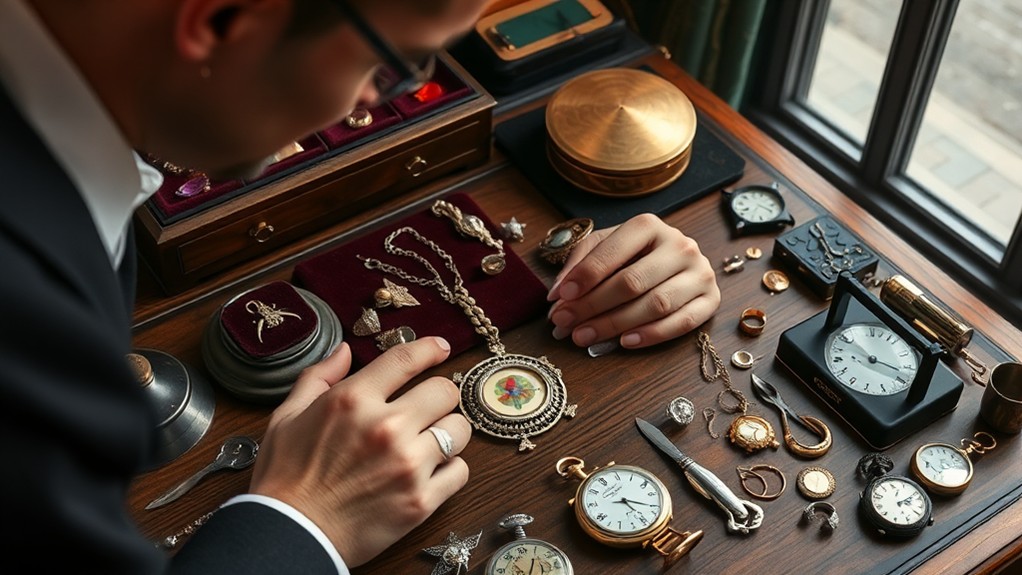
Professional appraisal expertise is vital when assessing estate jewelry value. When dealing with vintage jewelry, you'll need to rely on expert insights to determine its true value.
Professional appraisals provide accurate evaluations based on current market trends, ensuring you understand the full worth of your estate pieces.
Here's why professional appraisals are fundamental:
- Accurate valuation: Certified experts assess numerous aspects of your jewelry, including:
- Insurance replacement price
- Retail value
- Liquid value
- Fundamental value
- Authentication: Appraisers can verify the authenticity and craftsmanship of your pieces, which greatly impacts their marketability.
- Informed decision-making: With a clear understanding of your jewelry's worth, you can make better choices regarding insurance and resale.
- Material and design identification: Professionals can recognize valuable materials and rare designs that may enhance your jewelry's value.
To optimize the benefits of a professional appraisal:
- Choose a certified appraiser with expertise in estate jewelry
- Provide any available documentation or history of the pieces
- Ask questions about the valuation criteria and market trends affecting your jewelry's worth
Frequently Asked Questions
How Do I Find Out How Much My Inherited Jewelry Is Worth?
To determine your inherited jewelry's worth, you'll need to research its maker and history, consult certified appraisers, check for hallmarks, compare prices online, and document its condition. These steps will give you a thorough value assessment.
How Do I Find Out How Much My Vintage Jewelry Is Worth?
To find out your vintage jewelry's worth, you'll need to identify its age, examine craftsmanship, research hallmarks, compare prices online, and consider consulting a professional appraiser. These steps will help you determine its value accurately.
How to Evaluate Estate Jewelry?
To evaluate estate jewelry, you'll need to examine its design, historical significance, and maker's mark. Check the condition, identify materials used, and look for hallmarks. Consult certified appraisers for accurate valuations of different types.
Is Estate Jewelry Worth Anything?
Yes, estate jewelry can be quite valuable. You'll find that many pieces hold significant worth because of their rarity, craftsmanship, and materials. It's essential to get professional appraisals to determine the true value of your estate jewelry.
